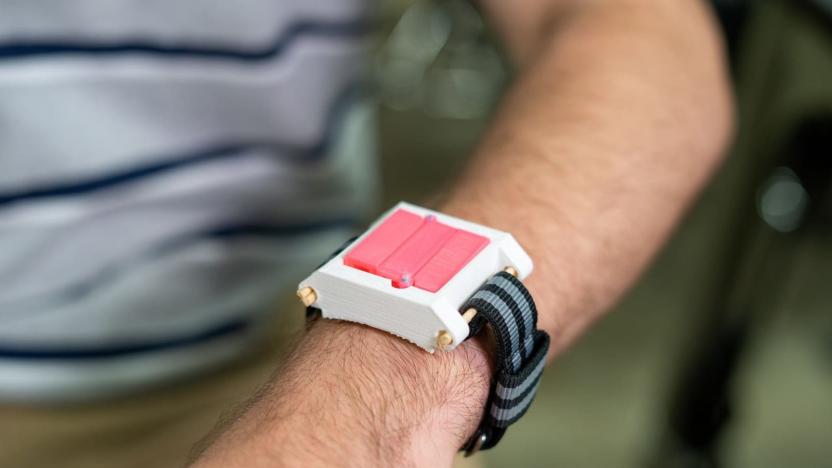allergy
Latest

The most common oral decongestant in the US does not work, FDA finds
The FDA ruled that phenylephrine, a key ingredient in many over-the-counter cold medications, does not actually work to treat nasal congestion when taken orally. The agency will now need to determine if it will revoke the ingredient's oral OTC designation as “safe and effective.”

Syringe 'watch' puts a life-saving allergy shot on your wrist
If you're prone to serious allergic reactions, carrying an epinephrine shot (such as an EpiPen) could be vital. Those shots are often bulky, though, and there's a real chance you could lose yours right before you need it. Students at Rice University have a (relatively) simple solution: put the shot on your wrist. They've developed a wearable, the EpiWear, that hides a foldable epinephrine syringe in a device not much larger than a watch. If you're in an emergency, you just need to unfold it, flick a safety lever and push a button when you're ready to inject the medicine into your thigh.

Google adds allergy forecast info to mobile search results
One antihistamine or two? Google is making sure hay fever sufferers can answer that question in double quick time, thanks to the new addition of pollen measurements in search results. Plug an allergy- or pollen-related query into your Android smartphone and search results will now include a simple breakdown of current and predicted pollen levels. The new type of rich card result is populated by data from The Weather Channel, and as always, you can get more detailed info by tapping on the card itself.

ICYMI: Salamander bot and allergy cells: Good for something
try{document.getElementById("aol-cms-player-1").style.display="none";}catch(e){}Today on In Case You Missed It: A robotic salamander was invented by the EPFL and has a true to life spinal cord. Also researchers at the University of Virginia School of Medicine found that immune cells that normally create an over-reaction in some people, resulting in allergies or asthma, may also protect people against a certain kind of fatal infection. Finally, University of Buffalo researchers are making their own lava, you know, for science. As always, please share any interesting tech or science videos you find by using the #ICYMI hashtag on Twitter for @mskerryd.

uHoo edges out other air quality monitors with extra sensors
We've now gotten to the point where we can rely on pigeons for monitoring outdoor air quality, and there are plenty of conventional options for indoor as well. But there's always room for improvement, which is why we're looking at the uHoo. Impressively, this pint glass-sized device packs up to five air pollutant sensors, thus allowing it to measure the usual dust and volatile organic compounds, as well as carbon dioxide, carbon monoxide and ozone -- these three can't be detected by most other monitors in the consumer market. On top of that, the uHoo can also keep an eye on the temperature, humidity and air pressure, which comes in handy as these contribute to our wellness, too. The live data is fed to your iOS or Android device via Wi-Fi, and the app will alert you when the air goes bad in one of the rooms.

Fitbit: skin irritations were allergies, new wristbands have a warning
Fitbit recalled its Force wearable back in February after owners reported skin irritation, but after an investigation, says it will not do the same for the Fitbit Flex. The New York Times reports that the company and the Consumer Product Safety Commission decided a recall was not necessary, as long as the company makes a few changes. New wristbands will ship with a warning that it contains nickel, a common allergy, as well as a sizing guide to keep users from making it too tight. In a just-posted (at such a convenient time) letter to customers, CEO & co-founder James Park said "we are now confident that our users who experienced allergic contact dermatitis likely reacted either to very small levels of methacrylates...or, to a lesser degree, nickel in the stainless steel casing." He goes on to say that Fitbit is taking this experience into account in the design for its next-generation trackers, which should include the new Charge and ChargeHR devices that recently surfaced.

Fitbit sees the future of wearables in advanced sensors, is still investigating skin irritation complaints
"We want to get to the point where we're trying to launch all our products globally," explains Fitbit founder and CEO James Park, when quizzed on why the company was in Japan, expanding the availability of the Fitbit Flex -- a year-old device that possibly should have been surpassed by the recently withdrawn Force. In the increasingly lucrative field of fitness wearables, Fitbit wants expand its presence in Asia, and this time that includes a new calorie-counting food database dedicated to what's found in a typical Japanese diet, alongside an expanded color range that will total eight different options. Problem-solving aside, the CEO also mentioned the company is already at work on what's next -- and it's unlikely to be a mere lifelogging app or a camera on the strap.

Neato Robotics' XV-21 vacuum sucks up pet hair and allergens, looks like a new-age SNES
Sure, iRobot may have a strong presence in the impending robot apocolypse world of autonomous vacuum cleaners, but lest we forget about the others like Neato Robotics. The company's introducing the retro-futuristic XV-21 Pet and Allergy Vacuum for those of us wanting rid our domains of sniffle-inducing dust particles. Although the XV-21 looks similar to last year's XV-12, it features a new filter for improved airflow and suction, which Neato claims will catch three-times as many tiny bits around your domain as its normal kit. If that wasn't enough, the cleaner is also loaded with newly developed bristled brush to aid in sweeping up the likes of pet hair while keeping its noise levels to a minimum. If you're ready to leave the cleaning to the bots, this little guy is set to hit shelves in late April for $429 alongside a $60 Pet and Allergy kit packed with the filter (30 bucks on its own) and brush. Current Neato owners shouldn't fret either, as the add-ons are compatible with all of the company's vacuums, requiring only an upgrade to the latest firmware via USB. You'll find the full details in the press release after the break.

Santa Fe WiFi foe strikes again: sues neighbor for using wireless devices, lives in a car
No, this isn't him, because the real Arthur Firstenberg (with or without a cat) would probably need more than an aluminum helmet to cure his "electromagnetic sensitivity," symptoms of which allegedly include stomach pains and memory loss. In fact, this man -- an active member of the anti-wireless group in Sante Fe -- has taken one step further by suing his bewildered neighbor 25 feet away for refusing to switch off her wireless devices, which he claims has forced him to stay at friends' or live in a car. We'd say just chill out, find some place in the middle of an African desert, and then fly out. Oh, wait. [Photo courtesy of Wally Glenn]

Santa Fe group allergic to RF wants WiFi banned
We've been hearing for years of that certain elusive breed of human that is extra-sensitive to certain radio frequencies and electromagnetic fields, so it was only a time before those wire-tethered folks took shot across our wireless-loving bow. According to a local NBC news affiliate, Sante Fe resident Arthur Firstenberg (not pictured right) has organized a group of electro-sensitive citizens to rally against WiFi and cellphone use in public space, claiming it violates the Americans with Disabilities Act. No doubt it is indeed a sticky situation, but we're pretty sure Firstenberg and co are going to have to do a little better than claiming to "get chest pain and it doesn't go away right away" if they really expect an entire city (or country) to cease using wireless communications. [Via Fark]

Pollen-sniffing robots put on duty in Japan
In yet another example of robots getting the short end of stick, a Japanese weather forecasting company is set to deploy a swarm of some 200 pollen-sniffing robots throughout the country, which will warn us humans of any impeding pollen-related dangers (and no doubt scare a few unsuspecting animals in the process). As you can see, the robots are of the spherical variety, and measure a scant one foot across and weigh in at about 2.2 pounds. Sticking true to creepy robot conventions, they also boast glowing eyes, which light up in one of five different colors to indicate the level of pollen in the air. Somewhat curiously, that information takes a rather roundabout way back to the company's headquarters, with 200 allergy suffers volunteering to keep watch on the robots and rely their status back to the company.

LG SteamWasher: now with allergen-reducing powers
Yeah, the SteamWasher has already found its way into a-many abodes, but LG is making said device attractive to even more individuals by adding a dose of allergen-reducing magic. Hailed as the "first washing machine proven to reduce allergens," the new units can be spotted by the unique Allergiene laundry cycle, which acts to reduce dust mites and pet dander (just to name a couple) on fabrics by some 95-percent. If you're not exactly keen on just taking LG's word for it, the machine is also certified asthma and allergy friendly by the AAFA, so yeah, there's that. Those anxious to stop sneezing every time they dress can grab one in a myriad finishes for $1,399 to $2,699, and once you've dropped that, why not pick up the matching SteamDryer for an extra $1,199 to $2,699?

Radio Allergy cancelled
Radio Allergy, Milestone's "Wii Compatible" shooter for the Gamecube, has finally been canned by publisher O3 Interactive after months of delays. We like cel-shading, and we like shooters, so we're a little sad. In a statement to Cubed3, O3 said that there was a hope of putting Radio Allergy on the Wii. No plan, but a hope.Aeropause then speculated that this hypothetical Wii release would be bundled with Karous, the current "last Dreamcast game ever" from Milestone, or-- even better, both Karous and Chaos Field, Milestone's first "last Dreamcast game ever." We do like the idea of more games, but we don't have any evidence of that right now. All we know is that we aren't getting Radio Allergy any time soon. At least we can all download the papercraft patterns from the Japanese website! Video game papercraft beats actual video games every time.

Europe's Ford Mondeo sports 'allergy tested interior'
While Ford struggles to do anything right here in the States, the firm's European-bound Mondeo should appeal to those who just so happen to suffer from allergies across the pond. The whip, which is being gratuitously dubbed the "most technologically advanced car ever launched by Ford in Europe," does indeed tout the German TÜV Rhineland group's "Allergy Tested Interior" seal of approval, and suffered through an "extensive series of scientifically verifiable tests" in order to receive it. Ford engineers reportedly strayed from using materials such as "latex, chrome, and nickel that can provoke allergic reactions in some people," and a high-performance pollen filter was also thrown in for good measure. The new Mondeo, allergy friendly interior and all, should be cruising onto European lots any day now.[Via CNET]

Another Brit allergic to cellphones, electromagnetic fields
Sure, we've heard of cellphones causing all sorts of medical troubles when not conjuring cancer in your ear, but the latest report of everyday consumer electronics wreaking havoc on humans comes from where else but the UK. Curiously, this isn't the first time England has been the site of allergic reactions to electromagnetic fields (EMF), and Manchester's Debbie Bird has been forced to make outlandish alterations to her home (and way of life) in order to avoid intense headaches, painful skin rashes, and bizarre eyelid swelling. Among the items she can't use are microwaves, BMWs (saywha?), and cellphones, and she has also coated her walls in pricey black carbon paint, covered her windows in "protective film," and weirdest of all, sleeps under a "silver-plated mosquito net" in order to curb her reactions. Now, what type of hidden superpowers are in her arsenal to counter such strange deficiencies?

Radio Allergy delayed to March
Bad news for both of the people that preordered this one. O3 have delayed the US release of Milestone's shmup Radio Allergy until March 30th. The game, known as Radilgy in Japan, was released on the Gamecube in May of last year. We understand the delay-- shooting games have so much text to translate. Or maybe they didn't want to bring the game out in the midst of a busy Gamecube release season. Also (and this is what makes this news item explicitly appropriate for Wii Fanboy) O3 have deployed the "Rhythm Tengoku trick" in marketing their game-- there's a little "Wii Compatible" icon on the box. They might as well use every tactic they can think of; we get the feeling that selling a shmup for the Gamecube in 2007 is harder than, well, a certain kind of frantic videogame that is notorious for difficulty.We'd actually like to see the "Wii Compatible" tactic used by other developers to sell localized versions of obscure titles from the Gamecube back catalog at budget prices, but we think it would take a more popular game to start a trend. What do you think?

Thanko's USB Mask circulates air, freaks out co-workers
Nah, USB-powered fans aren't anything special these days, but infusing a couple of 'em into a bizarre facial mask and marketing it to folks with allergies earns top marks in the outlandish department. Thanko, the folks who continually put the fun back into USB, is busting out yet another oddity that relies entirely on USB power and your willingness to suffer through public humiliation. The whirlwind mask purportedly circulates airs and filters the incoming flow in order to provide a constant stream of clean, "purified" air, which could actually be useful for secretaries or other cube-dwellers who are forced to inhale the same stale office air day after day. So if you've been having trouble breathing, and don't mind being tethered to your computer nor the constant whirring that'll surround your mouth, you can snag the USB Mask now for ¥2,480 ($21).[Via Engadget Japanese]










